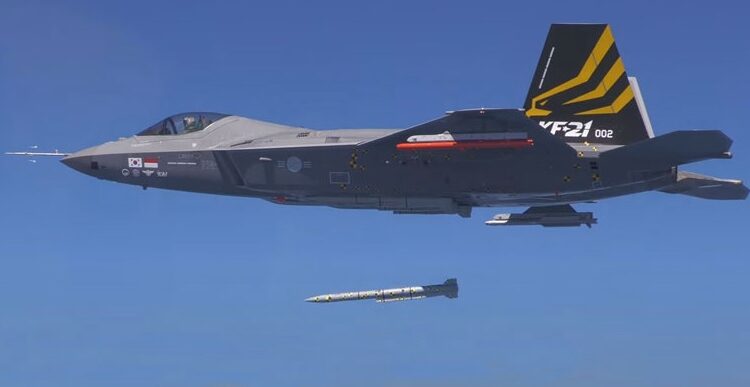KF-21 “Boramae” Fighter Jets to Be Stationed at Airbase 100km from North Korean Border
The South Korean Air Force (ROKAF) is likely to deploy its developing fighter aircraft at a military base in Gangneung, located in Gangwon Province, approximately 100km from the border with North Korea.
(DEFENCE SECURITY ASIA) — South Korea’s 4.5 generation fighter jet, the KF-21 “Boramae,” is set to be stationed near the North Korean border to enhance its capability to address aerial threats from the Pyongyang regime.
The South Korean Air Force (ROKAF) is likely to deploy its developing fighter aircraft at a military base in Gangneung, located in Gangwon Province, approximately 100km from the border with North Korea.
Currently, Gangneung is the leading candidate to serve as the “home” for South Korea’s premier defense industry fighter jet.
“Gangneung is strategically significant due to its proximity to North Korea and its capacity to provide the quickest response to threats posed by Pyongyang,” a senior South Korean official was quoted as saying by national media.
Currently, the airbase in Gangneung houses F-5 fighter jets.

Despite over 40 years of service with ROKAF, the F-5s remain essential due to several factors including quick preparation and rapid deployment capabilities.
Although still undergoing various tests, the 4.5 generation fighter jet KF-21 “Boramae” is set to begin mass production this year.
Korea Aerospace Industries (KAI) plans to spend approximately US$178 million (RM800 million) to start building 20 KF-21 “Boramae” aircraft this year, with an additional 20 units slated for next year for ROKAF.
It will take at least three years before the first KF-21 “Boramae” fighter jet is delivered to its initial customer, the South Korean Air Force, in 2026.
“The initial mass production of the KF-21 Boramae is expected to fill a power vacuum left as the South Korean Air Force phases out its aging fighter jets,” according to the country’s defense minister in a statement last December.
ROKAF plans to operate up to 120 KF-21 “Boramae” fighter jets by 2032 to replace its aging F-4 “Phantom” and F-5 aircraft, intending to make the KF-21 the “backbone” of ROKAF, playing a crucial role in any potential conflicts on the Korean Peninsula.

Additionally, South Korea plans to develop short-range air-to-air missiles for the KF-21 “Boramae.” The Defense Acquisition Program Administration (DAPA) estimates that the missile development program will cost about US$460 million (RM2 billion) and targets 2035 for production.
The fighter jet development program for the KF-21 began in 2015, but only truly commenced a few years later when KAI and its technology partners started building several prototype aircraft.
KAI received support from Lockheed Martin in the KF-21 development program, echoing the collaboration between the two companies during the development of the FA-50 light fighter.
The KF-21 prototype successfully completed its first flight in 2022 and has since undertaken about 2,000 test flights necessary to evaluate its various systems and components.
Launched in 2015, the KF-21 development program is projected to cost US$6.59 billion (RM26.36 billion).
KAI plans to supply 40 KF-21 Block 1 aircraft designed for air-to-air missions by 2026, followed by 80 Block 2 aircraft for air-to-ground missions in subsequent phases.

The South Korean aerospace giant also aims to begin exporting the KF-21 “Boramae” fighter jet to interested customers.
KAI has targeted several countries as potential customers for the KF-21 fighter jet, particularly nations that currently operate the FA-50/T-50 light fighter, such as Thailand, the Philippines, Iraq, Poland, and Malaysia.
With a reported unit price of US$65 million (RM260 million), the KF-21 (likely Block 1) is priced lower than other 4.5 generation aircraft such as the Rafale and Eurofighter Typhoon. — DSA



Comments are closed.